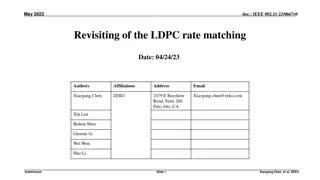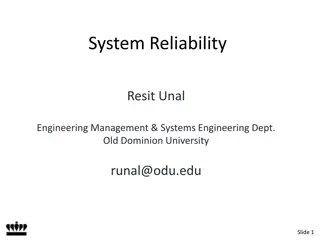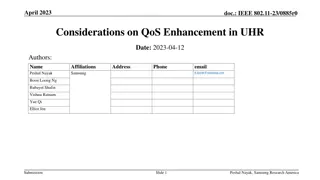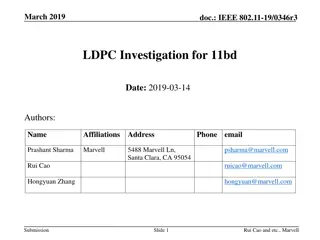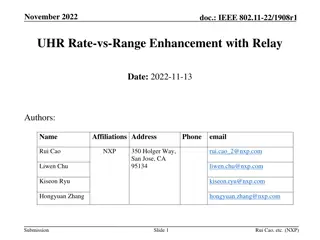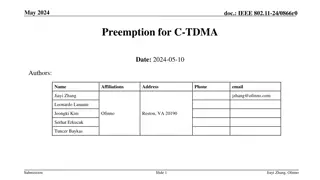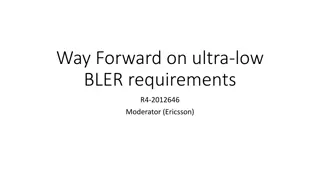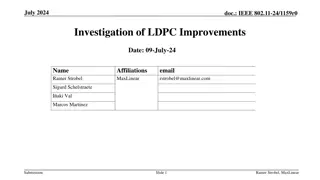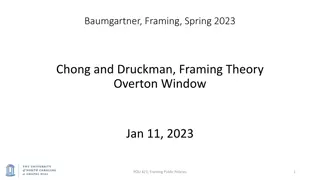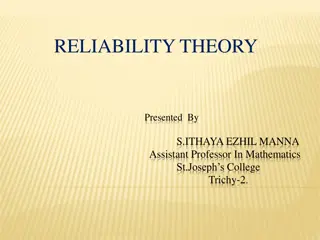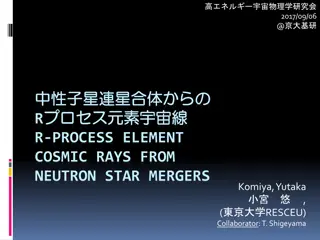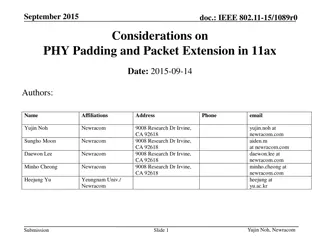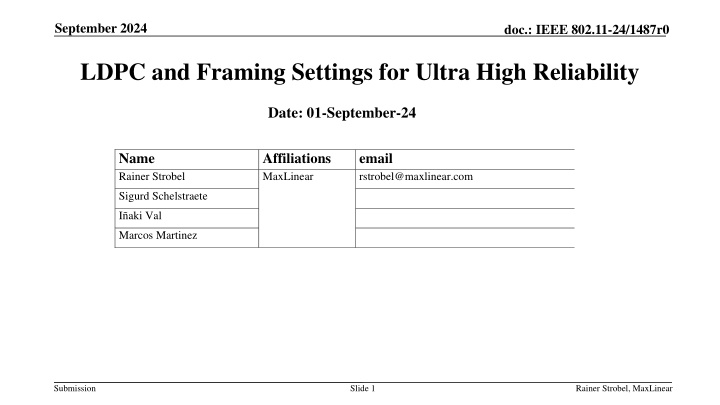
Enhancing Reliability and Latency in IEEE 802.11-24 Through LDPC and Framing Settings
Explore the improvements in LDPC codes and framing extensions proposed for enhancing reliability and reducing latency in IEEE 802.11-24 communication systems. The discussion includes strategies such as using more shortening, less repetitions, and unequal overhead distribution to protect initial data payloads effectively.
Download Presentation

Please find below an Image/Link to download the presentation.
The content on the website is provided AS IS for your information and personal use only. It may not be sold, licensed, or shared on other websites without obtaining consent from the author. If you encounter any issues during the download, it is possible that the publisher has removed the file from their server.
You are allowed to download the files provided on this website for personal or commercial use, subject to the condition that they are used lawfully. All files are the property of their respective owners.
The content on the website is provided AS IS for your information and personal use only. It may not be sold, licensed, or shared on other websites without obtaining consent from the author.
E N D
Presentation Transcript
September 2024 doc.: IEEE 802.11-24/1487r0 LDPC and Framing Settings for Ultra High Reliability Date: 01-September-24 Name Rainer Strobel Affiliations MaxLinear email rstrobel@maxlinear.com Sigurd Schelstraete I aki Val Marcos Martinez Submission Slide 1 Rainer Strobel, MaxLinear
September 2024 doc.: IEEE 802.11-24/1487r0 Introduction LDPC Improvements Larger size LDPC codes are part of the TGBN SFD [1, 2], which will provide higher performance [3] presents the rules for the LDPC codeword size and minimum number of LDPC codewords With further framing improvements, reliability and latency can be improved, especially for large PPDUs and high rates This paper discusses extensions framing extensions to increase reliability Use more shortening and less repetitions Unequal overhead distribution within the frame Specifically, to provide better protection for initial MPDUs of the payload Submission Slide 2 Rainer Strobel, MaxLinear
September 2024 doc.: IEEE 802.11-24/1487r0 Framing Parameters Review of other framing parameters: ?PLD ?DBPS ?pld 3888? Number of OFDM symbols: ?SYM= Number of LDPC codewords: ?cw= Shortening: Puncturing: Repetitions: Improvement potential: OFDM settings used for higher rates (high MCS, many carriers) lead to high number of repetition bits inefficient (see next slide) Unequal protection of initial symbols in the frame can improve reliability (if ?avbits>3888) ?shrt= max 0, ?CW?LDPC? ?PLD ?punc= max 0, ?CW?LDPC ?PLD ?shrt ?rep= max 0,?avbits ?CW?LDPC1 ? ?PLD Submission Slide 3 Rainer Strobel, MaxLinear
September 2024 doc.: IEEE 802.11-24/1487r0 Repetitions vs. Shortening Repetitions and shortening improve the packer error rate at the cost of higher overhead ? ?LDPC ?shrt ?CW ?CW+?rep ?eff= ?CW ?punc ?LDPC ?shrt ?CW Shortening is much more efficient than bit repetitions to increase robustness See figure: higher SNR gain for similar reduction in code rate For >1dB increased robustness, a change of code rate is most efficient MCS 8 (code rate , 256-QAM) Submission Slide 4 Rainer Strobel, MaxLinear
September 2024 doc.: IEEE 802.11-24/1487r0 Framing Changes for more Shortening ?pld 3888?) will give Increasing NCW to beyond the required minimum (?CW> more shortening and less repetition bits without further changes in the framing rules 3888?+4 ?pld 3888?t ?pld 3888? ?CW C ?CW= ?pld Submission Slide 5 Rainer Strobel, MaxLinear
September 2024 doc.: IEEE 802.11-24/1487r0 Variable Signal Quality within Frame Signal quality within a PPDU Due to receiver convergence, error rate at the frame start can be high Even a small penalty of 0.5-1dB causes a significant increase of errors Message Priority Some of the content of the frame may require increased protection, e.g., retransmitted packets SU beamformed transmission, 2x LTF, MCS4 Submission Slide 6 Rainer Strobel, MaxLinear
September 2024 doc.: IEEE 802.11-24/1487r0 Unequal Protection Framing Increase protection at the frame start Shortening bits are moved to the frame start Puncturing bits are used at the end Repetition bits are minimized (extra LDPC codewords) Submission Slide 7 Rainer Strobel, MaxLinear
September 2024 doc.: IEEE 802.11-24/1487r0 Latency Improvement with Unequal Protection Constant PER: Link adaptation assumption Actual situation: Higher PER at frame start Unequal protection: PER of initial symbols can be made lower than average PER Assumptions Receiver convergence as shown on Slide 6 Retransmitted packets at the PPDU start Fixed protection, 10 initial symbols, 1dB extra margin Avg. PER 0.1, mcs 4, 1 spatial stream Submission Slide 8 Rainer Strobel, MaxLinear
September 2024 doc.: IEEE 802.11-24/1487r0 Conclusions The Choice of LDPC framing parameters can be improved in several ways: Choosing shortening over repetition improves reliability ?pld 3888?, With a small change of the framing rules, e.g., allowing ?CW> more shortening bits and less repetition bits are used. LDPC parameters can be chosen to provide higher protection for the start of the payload, the retransmitted packets An unequal distribution of the puncturing and shortening bits within the frame provides a latency improvement. Submission Slide 9 Rainer Strobel, MaxLinear
September 2024 doc.: IEEE 802.11-24/1487r0 SP ???? ????? ? For increased reliability, allow ???> Yes No Abstain Submission Slide 10 Rainer Strobel, MaxLinear
July 2024 doc.: IEEE 802.11-24/1487r0 SP Do you agree to improve tail latency by uneqal protection of LDPC codewords within a frame? Yes No Abstain Submission Slide 11 Rainer Strobel, MaxLinear
September 2024 doc.: IEEE 802.11-24/1487r0 References [1] Rethna Pulikkoonattu et.al, Longer Block-Length LDPC Codes , IEEE 802.11-23-1985R4, 2024-05-12 [2] Rainer Strobel et.al, Investigation of LDPC Improvements , IEEE 802.11-24- 1159r1, 2024-07-09 [3] Sigurd Schelstraete et.al, UHR preamble signaling , IEEE 802.11-24 1461r0, 2024-08-29 Submission Slide 12 Rainer Strobel, MaxLinear

